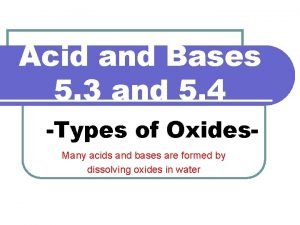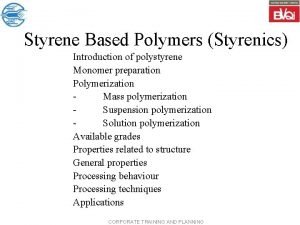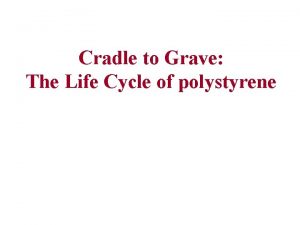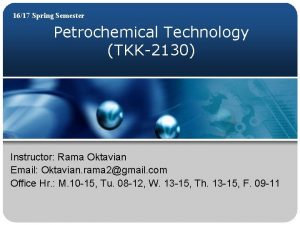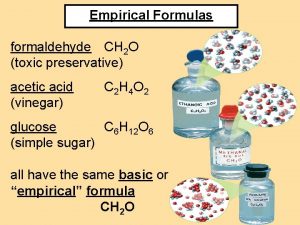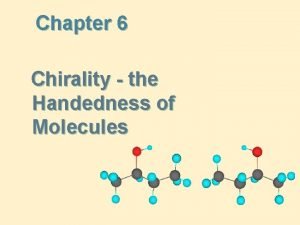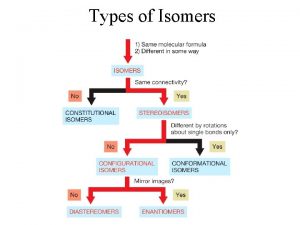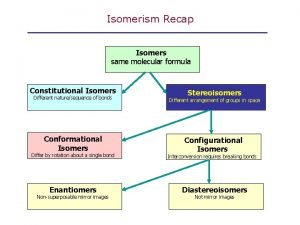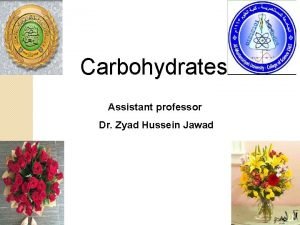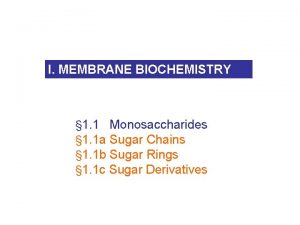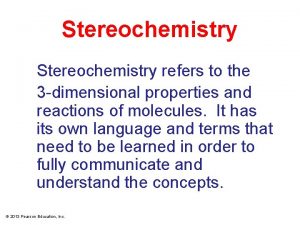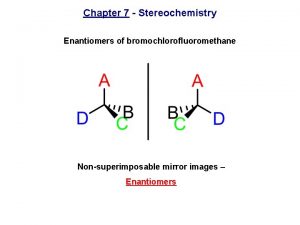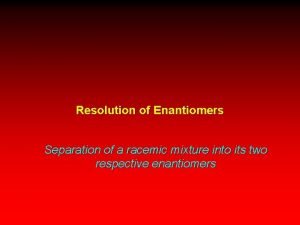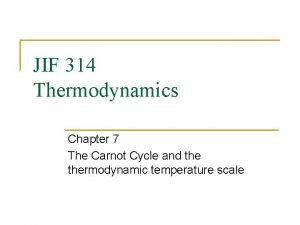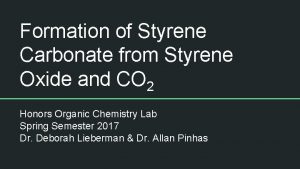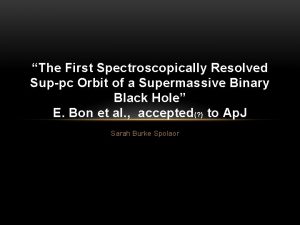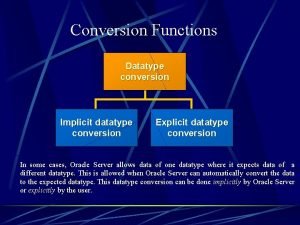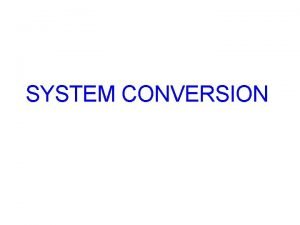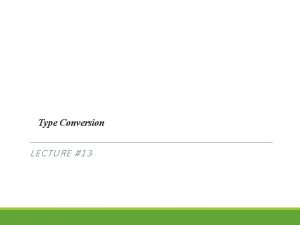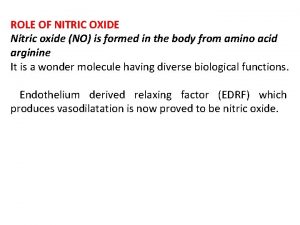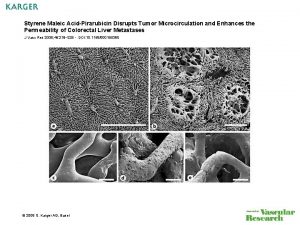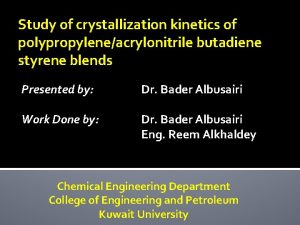The Conversion of Styrene Oxide Enantiomers into Spectroscopically














- Slides: 14

The Conversion of Styrene Oxide Enantiomers into Spectroscopically Distinguishable Diastereomers through Complexation with 3, 3, 3 -Trifluoro-1, 2 -Epoxypropane Mark D. Marshall, Helen O. Leung Department of Chemistry Amherst College Melanie Schnell, Sergio R. Domingos, Anna Krin FS-SMP, Deutsches Elektronen-Synchrotron (DESY) Supported by the National Science Foundation

Chiral analysis • Determine the absolute stereochemistry for an enantiopure analyte • Measure enantiomeric excess for a sample of mixed chirality (R)-Analyte + chiral tag Tag---R (S)-Analyte + chiral tag Tag---S Same rotational spectrum Diastereomers Different rotational spectra

Requirements for chiral tag • • • Easily available in enantiopure form Small, chiral molecule Easy to introduce into free-jet expansion Functionalized for noncovalent interactions Simple rotational spectrum § Minimal isotopic dilution (13 C, § No hyperfine § No internal rotation • Spectroscopically characterized • Structure determined 18 O helpful) 2 -(trifluoromethyl)-oxirane (TFO)

• Experimental methods Three chirped pulse Fourier transform microwave spectrometers in three countries and two continents • 6. 1 – 18. 1 GHz, 20 W (Amherst) • 2. 0 – 6. 0 GHz, 400 W (Alberta) • 2. 0 – 8. 0 GHz, 400 W (DESY) • • 0. 1% – 1% TFO in argon (Amherst), neon (Alberta), or helium (Alberta, DESY) is expanded through one (two at Amherst) pulsed valves with 0. 8 mm nozzle Multiple FIDs per gas pulse • 10 μs Amherst • 20 μs Alberta • 40 μs DESY Photo courtesy of Jessica Mueller, Amherst College • Long averaging • 50/100/200 k. Hz FWHM • • Some initial assignments and analysis using PGOPHER Final analysis using Kisiel’s AABS package in conjunction with Pickett’s SPFIT/SPCAT

Amherst Balle-Flygare FTMW Spectrometer • Used to observe (TFO)2 RR/SS 5 • 0. 5 % TFO in Argon (weak) • 0. 5 % TFO in Neon (better) • • • 6 – 22 GHz Cavity-enhanced sensitivity 1 MHz bandwidth Double heterodyne detection at 2. 5 MHz 10 MS/s digitization 1 k – 2 k data points Zero filled to 2 k – 4 k pts 1 – 5 k. Hz resolution 5 – 10 k. Hz linewidth Doppler doublets

(TFO)2 RR/SS 1 Ka = 5 – 4 b-type Q branch • • Lowest energy conformer First assigned at DESY, 2 – 8 GHz Also found in Amherst 6 – 18 GHz broadband spectrum (argon) and Alberta 2 – 6 GHz spectrum. Measurement uncertainty • • • 20. 0 k. Hz (Amherst) ~10 k. Hz (Alberta) ~6 k. Hz (DESY) 391 lines, 6 k. Hz rms Uncertainties adjusted with PIFORM B 3 LYP-GD 3 BJ//def 2 tzvp Exp. Theory A / MHz 1305. 78580(11) 1290 B / MHz 267. 047006(44) 266 C / MHz 246. 774863(49) 245

(TFO)2 RR/SS 5 • • J = 7 – 6 a-type • • Higher energy conformer First observed & assigned in Alberta, 2 – 6 GHz Not seen in Amherst broadband spectrum (argon) Extended to 20 GHz at Amherst (narrow band) Additional lines, 5 – 8 GHz, at DESY Measurement uncertainty • • • 1. 68 k. Hz (Amherst) 8. 87 k. Hz (Alberta) 6. 00 k. Hz (DESY) 254 lines, 5 k. Hz rms Χ 2 = 1. 00 B 3 LYP-GB 3 BJ//def 2 tzvp Exp. Theory A / MHz 1352. 20278(17) 1375 B / MHz 290. 382045(63) 282 C / MHz 276. 378429(66) 269

(TFO)2 heterochiral – not observed experimentally RS/SR 2 0 cm– 1 RS/SR 1 3. 7 cm– 1 A = 1721 MHz B = 228 MHz C = 222 MHz A = 1462 MHz B = 259 MHz C = 244 MHz μb = μa = μc =0 μa > μb >> μc B 3 LYP-GD 3 BJ/def 2 tzvp ZPE corrected Relaxed monomer geometry

Tagging styrene oxide • • • Small, chiral molecule Easy to introduce into free-jet expansion Simple rotational spectrum Spectroscopically characterized Structure determined Styrene oxide (SO)

TFO-SO – ABCluster RS/SR: 0 cm– 1 • • • Developed by Jun Zhang Locates minima via CHARMM force field Then optimize candidates with DFT • B 3 LYP-GD 3 BJ/def 2 tzvp • ZPE corrected • Relaxed monomer geometry RR/SS: 112 cm– 1 Zhang, J. ; Dolg, M. ABCluster: The Artificial Bee Colony Algorithm for Cluster Global Optimization. Phys. Chem. Phys. 2015, 17, 2417324181. Zhang, J. ; Dolg, M. Global Optimization of Rigid Molecular Clusters by the Artificial Bee Colony Algorithm. Phys. Chem. Phys. 2016, 18, 3003 -3010. http: //www. zhjun-sci. com/software-abcluster-download. php

TFO-SO – DFT predictions B 3 LYP-GD 3 BJ/def 2 tzvp ZPE corrected Relaxed monomer geometry RS/SR: 0 cm– 1 RR/SS: 112 cm– 1 A = 755 MHz B = 345 MHz C = 278 MHz A = 799 MHz B = 305 MHz C = 259 MHz μa > μb ≈ μc μa >> μb > μc

TFO-SO RS/SR J = 10 – 9 a-type • • • Normalized Intensity 0 Observed at DESY, 2 – 8 GHz 1% TFO in helium is expanded through one heated pulsed valve with liquid SO reservoir and 0. 8 mm nozzle 6 k. Hz measurement uncertainty Fit with SPFIT/SPCAT 266 lines, 4 k. Hz rms Uncertainties adjusted with PIFORM 20 40 6225 6230 6235 6240 6245 6250 6255 Frequency/MHz 6260 6265 6270 B 3 LYP-GB 3 BJ//def 2 tzvp 6275 Exp. Theory A / MHz 754. 996414(86) 755 B / MHz 343. 389276(55) 345 C / MHz 276. 525971(57) 278

TFO-SO RR/SS J = 10 – 9 a-type • • • Normalized Intensity 0 2 Observed at DESY, 2 – 8 GHz 1% TFO in helium is expanded through one heated pulsed valve with liquid SO reservoir and 0. 8 mm nozzle 6 k. Hz measurement uncertainty Fit with SPFIT/SPCAT 173 lines, 6 k. Hz rms Uncertainties adjusted with PIFORM 4 5650 5655 5660 5665 5670 5675 5680 Frequency/MHz 5685 5690 5695 5700 B 3 LYP-GB 3 BJ//def 2 tzvp Exp. Theory A / MHz 800. 86742(93) 799 B / MHz 305. 40820(12) 305 C / MHz 259. 85494(10) 259

Summary and future work • • • 2 -(trifluoromethyl)-oxirane is used to tag styrene oxide, converting enantiomers into spectroscopically distinguishable diastereomers. ABCluster followed by B 3 LYP/def 2 tzvp with GD 3 BJ empirical dispersion correction identifies suitable conformers and provides excellent estimates of rotational constants. Future work will include use of enantiopure 2 -(trifluoromethyl)-oxirane in determining its ability to successfully determine the enantiomeric excess of known styrene oxide samples.
 Acidic oxides formulas
Acidic oxides formulas Abs plastic
Abs plastic Styrene uses
Styrene uses Styrene monomer
Styrene monomer The empirical formula of styrene is ch
The empirical formula of styrene is ch Stereoisomers always possess handedness
Stereoisomers always possess handedness Horizontal line
Horizontal line Diastereomers vs constitutional isomers
Diastereomers vs constitutional isomers Enantiomers vs epimers
Enantiomers vs epimers Epimers and anomers
Epimers and anomers Are cis and trans diastereomers
Are cis and trans diastereomers Superimposable mirror image
Superimposable mirror image Resolution of enantiomers
Resolution of enantiomers Conversion of work into heat and vice versa
Conversion of work into heat and vice versa Phép trừ bù
Phép trừ bù
